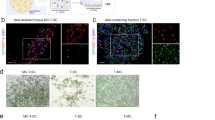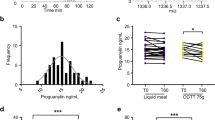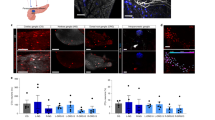Abstract
The exocrine pancreas, liver, and submandibular glands of the rat were used to express and secrete two exogenous, human protein hormones (growth hormone and insulin) into blood at physiological concentrations. Transfection, expression, and secretion were achieved by the in vivo retrograde injection of plasmid DNA into the secretory ducts of these glands. Pancreatic acinar cells secreted physiological concentrations of growth hormone into the circulation, and its secretion was enhanced by cholinergic stimulation. A human insulin gene was engineered to allow normal processing of insulin in non-β cells. With this gene, the secretion of human insulin by the exocrine pancreas normalized elevated blood glucose levels in diabetic rats. These in vivo observations demonstrate the utility of retrograde ductal administration of naked DNA into exocrine organs as a novel method for the regulated systemic delivery of protein-based Pharmaceuticals.
This is a preview of subscription content, access via your institution
Access options
Subscribe to this journal
Receive 12 print issues and online access
$209.00 per year
only $17.42 per issue
Buy this article
- Purchase on Springer Link
- Instant access to full article PDF
Prices may be subject to local taxes which are calculated during checkout
Similar content being viewed by others
References
Crystal, R.G. 1995. Transfer of genes to humans: early lessons and obstacles to success. Science 270: 404.
Lever, A.M. and Goodfellow, P. 1995. pp. 1–91 in Gene therapy. Churchill Livingstone, New York.
Friedmann, T. 1996. Human gene therapy—an immature genie, but certainly out of the bottle. Nature Med. 2: 144.
Buckel, P. 1996. Recombinant proteins for therapy. Trends Pharma. Sci. 17: 450.
Liebow, C. 1988. Nonparallel pancreatic secretion: its meaning and implications. Pancreas 3: 343–351.
Saito, A. and Kanno, T. 1973. Concentration of pancreozymin as a determinant of the exocrine-endocrine partitioning of pancreatic enzymes. Jpn. J. Physiol. 23: 477–95.
Isenman, L.D. and Rothman, S.S. 1977. Transport of α-amylase across the basolateral membrane of the pancreatic acinar cell. Proc. Natl. Acad. Sci. USA 74: 4068–4072.
Papp, M., Feher, S., Nemeth, E.P., Somogyi, V. and Folly, G. 1980. Exit routes for secretory proteins from the dog pancreas. Acta Physiol. Acad. Sci. 56: 401–410.
Geokas, M.C., Largman, C., Brodrick, J.W. and Fassett, M. 1980. Molecular forms of immunoreactive pancreatic elastase in canine pancreatic and peripheral blood. Am. J. Physiol. 238: 238–246.
Miyasaka, K. and Rothman, S.S. 1981. The endocrine secretion of α-amylase by the pancreas Am. J. Physiol. 241: 170–175.
Grendell, J.H. and Rothman, S.S. 1982. The effect of changes in circulating amylase levels on amylase output in bile Am. J. Physiol. 243: 54–59.
Niederau, C., Grendell, J.H. and Rothman, S.S. 1985. The effects of proglumide on ductal and basolateral secretion of pancreatic digestive enzymes. Am. J. Physiol. 249: 100–107.
O'Connell, B.C., Xu, T., Walsh, T.J., Sein, T., Mastrangeli, A., Crystal, R.G. et al. 1996. Transfer of a gene encoding the anticandidal protein histatin 3 to salivary glands. Hum. Gene Ther. 7: 2255–2261.
Adesanya, M.R., Redman, R.S., Baum, B.J. and O'Connell, B.C. 1996. Immediate inflammatory responses to adenovirus-mediated gene transfer in rat salivary glands. Hum. Gene Ther. 7: 1085–1093.
Raper, S.E. and DeMatteo, R.P. 1996. Adenovirus-mediated in vivo gene transfer and expression in normal rat pancreas. Pancreas 12: 401–410.
Barka, T. and Van der Noen, H.M. 1996. Retrovirus-mediated gene transfer into salivary glands in vivo. Hum. Gene Ther. 7: 613–618.
O'Connell, B.C., Ten Hagen, K.G., Lazowski, K.W., Tabak, L.A. and Baum, B.J. 1995. Facilitated DNA transfer to rat submandibular gland in vivo and GRP-Ca gene regulation. Am. J. Physiol. 268: 1074–1078.
Mastrangeli, A., O'Connell, B., Aladib, W., Fox, P.C., Baum, B.J. and Crystal, R.G. 1996. Direct in vivo adenovirus-mediated gene transfer to salivary glands. Am. J. Physiol. 266: 1146–1155.
Kagami, H., O'Connell, B.C. and Baum, B.J. 1996. Evidence for the systemic delivery of a transgenic product from salivary glands. Hum. Gene Ther. 7: 2177–2184.
Hahn, T.M., Copeland, K.C. and Woo, S.L.C. 1996. Phenotypic correction of dwarfism by constitutive expression of growth hormone. Endocrinol. 137: 4988.
Kolodka, T.M., Finegold, M., Moss, L. and Woo, S.L.C. 1995. Gene therapy for diabetes mellitus in rats by hepatic expression of insulin. Proc. Natl. Acad. Sci. USA 92: 3293–3297.
Schneider, S.W., Sritharan, K.C., Geibel, J.P., Oberleithner, H. and Jena, B.P. 1997. Surface dynamics in living acinar cells imaged by atomic force microscopy: Identification of plasma membrane structures involved in exocytosis. Proc. Nat. Acad. Sci. USA 94: 316–321.
Melese, T. and Rothman, S.S. 1983. Distribution of three hexose derivatives across the pancreatic epithelium: paracellular shunts or cellular passage? Biochem. Biophys. Acta 763: 212–219.
Melese, T. and Rothman, S.S. 1983. The pancreatic epithelium is permeable to sucrose and inulin across secretory cells. Proc. Nat. Acad. Sci. USA 80: 4870–4874.
Rothman, S.S. 1989. The regulation of digestive reactions by the pancreas, pp. 465–476 in Handbook of physiology: the gastrointestinal system III. Forte, J.G. (ed.). Oxford University Press, New York.
German, M.S. and Wang, J. 1994. The insulin gene contains multiple transcriptional elements that respond to glucose. Mol. Cell Biol. 14: 4067–4075.
Author information
Authors and Affiliations
Rights and permissions
About this article
Cite this article
Goldfine, I., German, M., Tseng, HC. et al. The endocrine secretion of human insulin and growth hormone by exocrine glands of the gastrointestinal tract. Nat Biotechnol 15, 1378–1382 (1997). https://doi.org/10.1038/nbt1297-1378
Received:
Accepted:
Issue Date:
DOI: https://doi.org/10.1038/nbt1297-1378
This article is cited by
-
Regenerative medicine and cell-based approaches to restore pancreatic function
Nature Reviews Gastroenterology & Hepatology (2017)
-
Anchored phosphatases modulate glucose homeostasis
The EMBO Journal (2012)
-
Plasmid DNA is internalized from the apical plasma membrane of the salivary gland epithelium in live animals
Histochemistry and Cell Biology (2012)
-
New β-cells from old acini
Nature Biotechnology (2008)
-
Secretory cargo composition affects polarized secretion in MDCK epithelial cells
Molecular and Cellular Biochemistry (2008)



